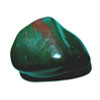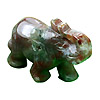- sale
- new items
- lovely beads
- wedding beads
- beads for teens
- for custom order
- newsletter
- recognition
- testimonials
- birthstones
- zodiac signs
- jewelry guide
SHOP BAG
![]() in your bag 0 items
in your bag 0 items
Bloodstone is the original birthstone for March. Today, bloodstone, jasper and aquamarine are all considered the gemstones for March. The mineral bloodstone, also known as heliotrope, is a form of chalcedony. The "classic" bloodstone is green chalcedony with red inclusions of iron oxide or red jasper. Sometimes the inclusions are yellow, in which case the mineral is given the name plasma. It also occurs in shades of dark green with red, brown and multicolored spots.
The red inclusions are supposed to resemble spots of blood; hence the name "bloodstone". The name "heliotrope" (from Greek HELIOS - Sun, and TREPEIN - to turn) derives from various ancient notions about the manner in which the mineral reflects light. Perhaps the appearance of the gem reminded the ancients of the red setting sun, mirrored in the ocean.
The primary source of the stone is India. It is also found in Brazil, China, Australia, Kathiawar Peninsula in India, Germany, Scotland, Czech Republic, Russia and the United States (Wyoming).
In ancient times bloodstone was thought to have the ability to stop hemorrhages by merely touching the stone. Ancient warriors often carried a bloodstone amulet which was intended to stop the bleeding when applied to a wound.
Engraved bloodstone was used by the Babylonians in divination, and both they and the ancient Egyptians used it to magically defeat enemies, usually by employing the stone's abilities to increase personal strength and yet make its wearer "invisible" when they wanted attention focused strategically elsewhere. The Leyden Papyrus declared that "The world has no greater thing than bloodstone," it opens all doors for its owner, breaks down the walls of prisons and averts many disasters.
In the Middle Ages the red spots were thought to be the blood of Jesus, according to a legend, it was first formed when drops of Christ's blood fell and stained some jasper at the foot of the cross. Boccaccio writes about making one "invisible" in his Decameron. Medieval Christians often used bloodstone to carve scenes of the crucifixion and martyrs, and in sculptures representing flagellation and martyrdom, leading it to also be dubbed "martyr's stone".



